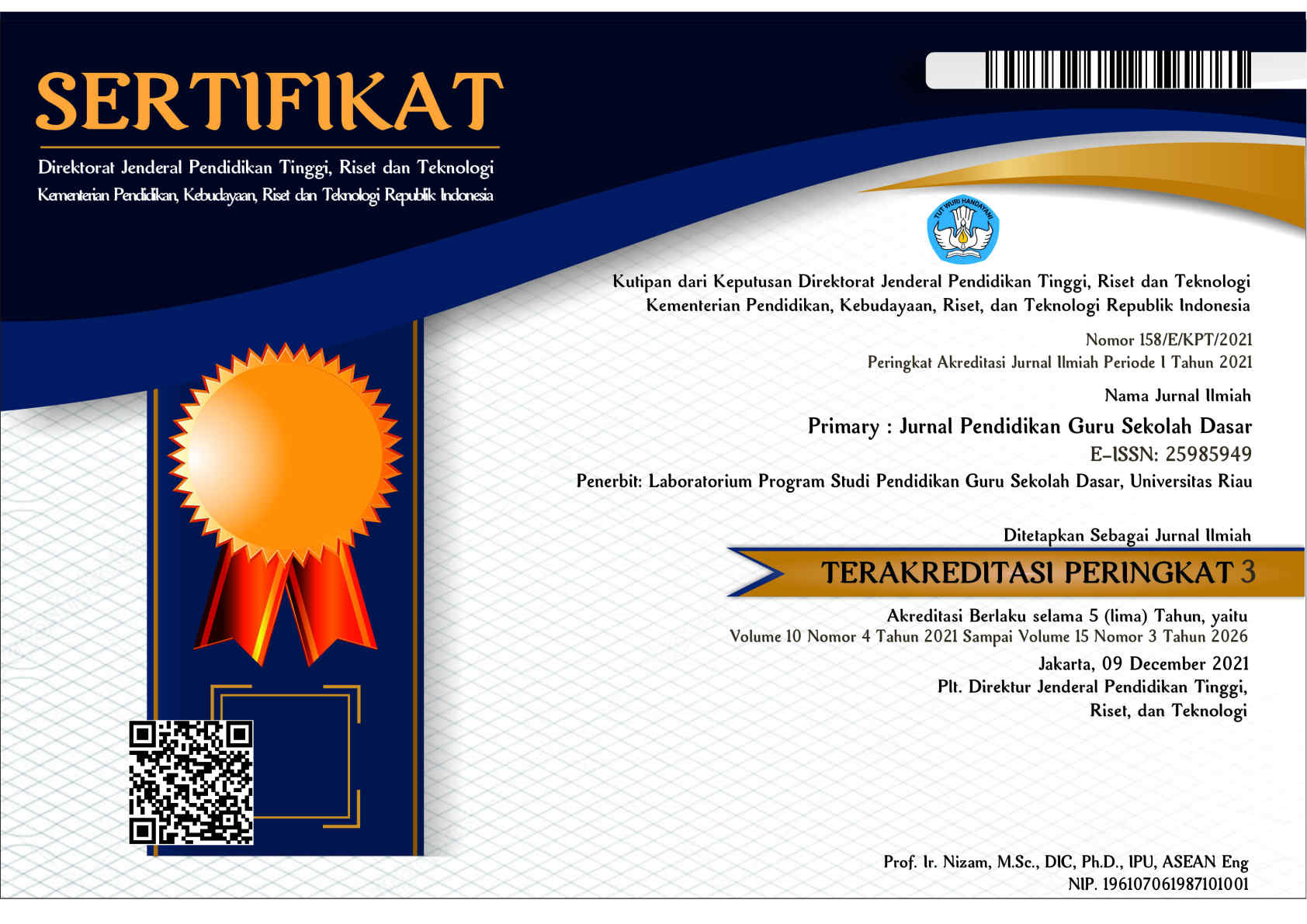Empathic Approach in Classroom Activities to Support Gender-Responsive Education at the Sixth-Grade Elementary Students
Abstract
This paper examines the role of empathy in fostering a gender-sensitive atmosphere in elementary schools, especially among sixth-grade students. It seeks to address the issue of lack of empathy, which has been linked to the prevalence of sexism, misogyny, and sexual abuse in today’s society. The research objective is to assess the efficiency of incorporating an empathetic approach in classroom activities to enhance gender awareness among students. The research uses a qualitative experimental design and an empathetic approach by applying Gender Responsive Scorecard (GRS) and Empathy map as the foundation of activities design. The research result indicates and provides evidence of the effectiveness of the empathic approach in improving students' understanding of experiences that differ from their own, especially regarding gender. In addition, the results will guide educators and researchers on how to incorporate an empathetic approach in promoting gender responsiveness in the classroom.
Keywords
Full Text:
PDFReferences
Agbevanu, W. K., Nudzor, H. P., Tao, S., & Ansah, F. (2021). Promoting Gender Equality in Colleges of Education in Ghana Using a Gender-Responsive Scorecard * . https://doi.org/10.1108/s2055-364120210000037010
Arda Sürücü, N., Özcan, E., & Özdamar, K. (2021). Empathic approach to reducing the negative attitudes of nursing undergraduate students towards cancer. Journal of Cancer Education, 36(3), 751-758.
Batson, C. D., Fultz, J., & Schoenrade, P. A. (1987). Distress and empathy: Two qualitatively distinct vicarious emotions with different motivational consequences. Journal of Personality, 55(1), 19-39.
Beasley, C. (1999). What's feminism got to do with it? Inventing and repositioning the Third Wave of feminism. Women's Studies International Forum, 22(3), 281-290.
Blair, R. J. (2005). Responding to the emotions of others: Dissociating forms of empathy through the study of typical and psychiatric populations. Consciousness and Cognition, 14(1), 698-718.
Cameron, L., Rutland, A., Brown, R., & Douch, R. (2020). Perspective-taking and empathy: Generalization across cultures. Journal of Cross-Cultural Psychology, 51(2), 105-122. doi:10.1177/0022022119887757
Cuff, B. M. P., Brown, S. J., Taylor, L., & Howat, D. J. (2016). Empathy: A review of the concept. In Emotion Review (Vol. 8, Issue 2, pp. 144–153). SAGE Publications Ltd. https://doi.org/10.1177/1754073914558466
Davis, J., & Nixon, C. (2017). Using empathy-based activities to challenge gender stereotypes and promote gender equality among university students. Journal of Gender Studies, 26(2), 161-177. doi:10.1080/09589236.2016.1229394
Davis, M. H. (1983). Measuring individual differences in empathy: Evidence for a multidimensional approach. Journal of Personality and Social Psychology, 44(1), 113-126.
Decety, J., & Cowell, J. M. (2014). Friends or foes: Is empathy necessary for moral behavior? Perspectives on Psychological Science, 9(5), 525-537.
Decety, J., & Jackson, P. L. (2004). The functional architecture of human empathy. Behavioral and Cognitive Neuroscience Reviews, 3(2), 71-100.
Duan, C., Hill, C. E., Crowell, J. A., MacDermid Wadsworth, S., & Solberg Nes, L. (2015). The impact of empathic attunement on military spouses' depression and anxiety symptoms. Journal of Family Psychology, 29(3), 368-377.
Eagly, A. H., & Karau, S. J. (2021). Role congruity theory of prejudice toward female leaders. In P. Glick & S. T. Fiske (Eds.), The Sage Handbook of Gender and Psychology (pp. 259-277). Sage Publications.
Eisenberg, N., Cumberland, A., & Spinrad, T. L. (2010). Empathy-related responding and prosocial behaviour. In M. Mikulincer & P. R. Shaver (Eds.), Prosocial motives, emotions, and behavior: The better angels of our nature (pp. 129-148). American Psychological Association.
Frosch, C. A., Schoppe-Sullivan, S. J., & O’Banion, D. D. (2021). Parenting and Child Development: A Relational Health Perspective. In American Journal of Lifestyle Medicine (Vol. 15, Issue 1). https://doi.org/10.1177/1559827619849028
Galinsky, A. D., Maddux, W. W., Gilin, D., & White, J. B. (2008). Why it pays to get inside the head of your opponent: The differential effects of perspective taking and empathy in negotiations. Psychological Science, 19(4), 378-384.
Gross, J. J., & Thompson, R. A. (2007). Emotion regulation: Conceptual foundations. In J. J. Gross (Ed.), Handbook of Emotion Regulation (pp. 3-24). Guilford Press.
Guanes, R. F., Vasques, A. M., de Carvalho, A. R., & de Oliveira, M. B. (2022). Empathic approaches in engineering capstone design projects: Student beliefs and reported behavior. Engineering Education, 17(1), 113-124.
Gündoğdu, D. & Kılınç, E. G. (2020). Challenging traditional gender norms: The role of empathy in promoting gender equality among university students. Sex Roles, 83(7-8), 539-551.
Hoffman, M. L. (2020). Empathy and moral development: Implications for caring and justice. Cambridge University Press.
Kahn, J. H., Huebner, E. S., & Bachman, M. (2017). Empathy and social activism: A person-centered approach to examining pathways toward engaging in activism. Journal of Community Psychology, 45(5), 631-644.
Kolko, J. (2010). Exposing the magic of design: A practitioner's guide to the methods and theory of synthesis. Oxford University Press.
Macaulay, C., & Griffin, M. (2016). Student social justice activism: The role of empathy and multicultural competence. Journal of College Student Development, 57(8), 937-953.
Mayer, J. D., Roberts, R. D., & Barsade, S. G. (2008). Human abilities: Emotional intelligence. Annual Review of Psychology, 59, 507-536.
Padilla-Walker, L. M., Carlo, G., Christensen, K. J., & Yorgason, J. B. (2016). Bidirectional relations between authoritative parenting and adolescents' prosocial behaviors. Journal of Research on Adolescence, 26(1), 174-183.
Riess, H. (2017). The Science of Empathy. Journal of Patient Experience, 4(2). https://doi.org/10.1177/2374373517699267
Smith, E. R., Mackie, D. M., & Claypool, H. M. (2019). The social psychology of inclusion and exclusion. Psychology Press.
United Nations Development Programme. (2014). UNDP gender equality strategy 2014–2017. New York, NY: UNDP.
Weisz, E., & Cikara, M. (2021). Strategic Regulation of Empathy. In Trends in Cognitive Sciences (Vol. 25, Issue 3). https://doi.org/10.1016/j.tics.2020.12.002
DOI: http://dx.doi.org/10.33578/jpfkip.v12i6.10228
Refbacks
- There are currently no refbacks.
Copyright (c) 2023 Vera Sardila, R. Hariyani Susanti, Muhammad Ilham Syarif, Aramudin Aramudin

This work is licensed under a Creative Commons Attribution-NonCommercial-ShareAlike 4.0 International License.
____________________________________________________________
Primary: Jurnal Pendidikan Guru Sekolah Dasar
Secretariat
Program Studi Pendidikan Guru Sekolah Dasar
Gedung B1, FKIP Universitas Riau
Kampus Bina Widya Km. 12,5 Simpang Baru Panam
Pekanbaru Riau Indonesia 28293
e-mail : primary@ejournal.unri.ac.id



